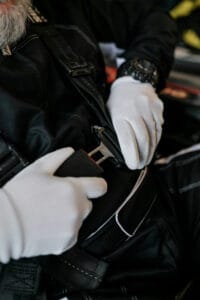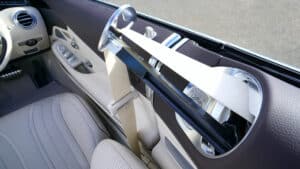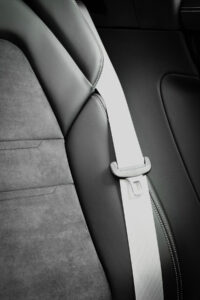When it comes to automotive safety, few inventions have had as significant an impact as the seat belt. Seat belts are the first line of defense in preventing injuries and saving lives during vehicle collisions. Designed with a simple yet ingenious mechanism, seat belts are engineered to secure occupants in their seats and minimize the risk of severe injuries. If you are properly wearing a seat belt in the event of an accident, the cost of Idaho Falls auto body repair may be your only expense.
Let’s delve into the inner workings of seatbelts and explore how they work to keep you safe on the road.
The Three-Point Seat belt
 The three-point seat belt is the most common type of seat belt found in modern vehicles. It consists of a lap belt and a shoulder belt, forming a diagonal strap across the occupant’s torso. This design offers superior protection compared to older models, such as lap belts alone. The three-point seat belt effectively distributes the forces of a crash over the body’s strongest structures, reducing the likelihood of severe injuries.
The three-point seat belt is the most common type of seat belt found in modern vehicles. It consists of a lap belt and a shoulder belt, forming a diagonal strap across the occupant’s torso. This design offers superior protection compared to older models, such as lap belts alone. The three-point seat belt effectively distributes the forces of a crash over the body’s strongest structures, reducing the likelihood of severe injuries.
The lap belt portion of the seat belt rests across the pelvis, specifically designed to restrain the lower body. By securing the pelvis, the lap belt prevents occupants from sliding forward or being ejected from the vehicle upon impact.
The shoulder belt crosses diagonally over the chest and shoulder, providing crucial upper body restraint. This belt restrains the upper body and limits the forward motion during a collision. By doing so, it helps prevent the occupant from striking the steering wheel, dashboard, or windshield.
The combination of the lap and shoulder belts ensures that the forces exerted during a crash are spread across the body’s strong areas, such as the ribcage, pelvis, and shoulders, minimizing the risk of severe injuries.
Restraint and Distribution of Forces
Seat belts play a crucial role in restraining occupants during a collision, effectively managing and distributing the forces generated by the impact. Here’s how seat belts achieve this:
- Restraining Occupants: When a vehicle suddenly stops or changes direction due to a crash, the occupants continue to move forward at their previous speed. Seat belts restrain the occupants, preventing them from being thrown out of their seats and minimizing the risk of ejection. By keeping occupants securely in place, seat belts enable the other safety features, such as airbags, to work more effectively. There are also similar mechanisms that go into how airbags work as well.
- Spreading Forces: In a collision, the seat belt spreads the forces of the impact across the body’s stronger areas. Rather than concentrating the impact on a single vulnerable point, such as the chest or head, the seat belt distributes the forces over a larger area. This distribution helps to reduce the severity of injuries by preventing concentrated impacts and reducing the risk of fractures or internal organ damage.
- Deceleration: Seat belts also contribute to decelerating the body in a controlled manner during a collision. By allowing the body to gradually come to a stop, rather than abruptly hitting a solid object, the seat belt helps mitigate the forces exerted on the body. This controlled deceleration helps to minimize the risk of injuries to the head, neck, and spine.
Seat belts are designed to withstand substantial forces and are rigorously tested to ensure their effectiveness in various crash scenarios. They are engineered to provide the optimal balance between restraining occupants and reducing the risk of injuries caused by excessive force or sudden deceleration.
Locking Mechanisms: Pretensioners and Load Limiters
 Seat belts are equipped with additional safety features known as pretensioners and load limiters, which work in conjunction with the basic seat belt mechanism to enhance occupant safety. Let’s take a closer look at each of these locking mechanisms:
Seat belts are equipped with additional safety features known as pretensioners and load limiters, which work in conjunction with the basic seat belt mechanism to enhance occupant safety. Let’s take a closer look at each of these locking mechanisms:
- Pretensioners: Pretensioners are devices that automatically tighten the seat belt in the event of a collision or rapid deceleration. They are typically located in the belt retractor mechanism. When a crash is detected, the pretensioner activates and rapidly removes any excess slack from the seat belt, pulling it snugly against the occupant’s body. This tightening action minimizes the forward movement of the occupant, effectively reducing the potential for injuries.
- Load Limiters: Load limiters are designed to limit the maximum force applied by the seat belt on the occupant’s body. They work in conjunction with the pretensioners and are often integrated into the seat belt retractors. In a high-impact scenario, load limiters allow a controlled amount of webbing to be released from the seat belt, reducing the force applied to the occupant. By absorbing and distributing the impact forces, load limiters help prevent excessive pressure on the chest and reduce the risk of rib fractures or internal injuries.
The combination of pretensioners and load limiters provides an additional layer of safety during a collision. Pretensioners ensure that the seat belt is properly tightened, minimizing the potential for slack and improving the overall effectiveness of the restraint system. Load limiters, on the other hand, help prevent excessive force on the body, reducing the risk of injuries caused by the seat belt itself.
It’s important to note that these locking mechanisms are designed to work in conjunction with the basic seat belt mechanism, reinforcing the primary function of seat belts in securing occupants and minimizing injuries.
Seat belt Materials and Design
 Seat belts are engineered with specific materials and designs to ensure their strength, durability, and ability to protect occupants in the event of a collision. Here are some key aspects of seat belt materials and design:
Seat belts are engineered with specific materials and designs to ensure their strength, durability, and ability to protect occupants in the event of a collision. Here are some key aspects of seat belt materials and design:
- Webbing Material: The seat belt webbing, which forms the straps that restrain the occupant, is typically made of high-strength materials such as polyester or nylon. These materials are chosen for their durability, resistance to stretching, and ability to withstand high forces. The webbing is tightly woven to provide strength and is specifically engineered to absorb energy during a crash.
- Retractor Mechanism: Seat belt retractors are responsible for storing and releasing the webbing as needed. They use a combination of springs and locking mechanisms to ensure the seat belt remains taut and secure during normal driving conditions while allowing controlled extension during a crash. The retractors are designed to lock when sudden deceleration or excessive force is detected.
- Stitching and Anchorage Points: Seat belt stitching is crucial for maintaining the integrity of the webbing. High-strength stitching techniques, such as box or X-pattern stitching, are used to reinforce the seat belt and prevent it from unraveling or tearing during a collision. The anchorage points where the seat belt attaches to the vehicle’s structure are also engineered to withstand substantial forces.
- Pretensioning Devices: As discussed earlier, pre-tensioning devices (pretensioners) are integrated into the seat belt system. These devices utilize various mechanisms, such as pyrotechnic charges or gas generators, to rapidly retract the seat belt and remove any slack upon detecting a crash. This ensures immediate occupant restraint and reduces the potential for excessive forward movement.
- Adjustable Features: Seat belts are often equipped with adjustable features to accommodate occupants of different sizes and provide a comfortable fit. Adjustable shoulder height positions and belt length adjusters allow occupants to customize the fit for optimal safety and comfort.
The materials and design elements of seat belts are continuously improved and tested to meet rigorous safety standards. Automakers and safety organizations conduct extensive research and development to enhance seat belt effectiveness and occupant protection.
Proper Seat belt Usage and Maintenance
 While seat belts are an essential safety feature in vehicles, their effectiveness relies on proper usage and maintenance. Here are some guidelines for ensuring the optimal use of seat belts:
While seat belts are an essential safety feature in vehicles, their effectiveness relies on proper usage and maintenance. Here are some guidelines for ensuring the optimal use of seat belts:
- Buckle Up Correctly: When getting into a vehicle, always buckle up before starting the engine. Insert the metal tongue into the buckle until you hear a click, indicating that it is securely latched. Ensure that the lap belt rests low and snug across your hips, while the shoulder belt crosses your chest diagonally and rests over your shoulder. Avoid wearing the seat belt under your arm or behind your back, as this reduces its effectiveness.
- Adjust for Proper Fit: Seat belts come with adjustable features to accommodate different body sizes. Take the time to adjust the shoulder height position and belt length to ensure a proper fit. The lap belt should be positioned low across the hips, not the stomach, while the shoulder belt should lie comfortably across the chest and shoulder, avoiding contact with the neck or face.
- One Person, One Belt: Each occupant in the vehicle should have their own seat belt. Never share seat belts or buckle up more than one person in a single seat belt, as this significantly reduces the protection offered to each individual.
- Seat belt for All Seating Positions: Whether you’re in the front or back seat, always wear your seat belt. Seat belts are crucial for both drivers and passengers, regardless of their seating position, as they provide vital protection in the event of a crash or sudden stop.
- Seat belt for Every Trip: Make it a habit to wear your seat belt on every trip, no matter how short or familiar the route may be. Accidents can happen unexpectedly, and wearing a seat belt even during routine drives significantly reduces the risk of severe injuries.
- Regularly Inspect and Maintain: Ensure that your seat belts are in good working condition. Periodically inspect the webbing for signs of fraying, cuts, or damage. Check the retractor mechanism to ensure it operates smoothly and locks securely during sudden stops. If you notice any issues or concerns, have your seat belts inspected and repaired by a qualified professional.
Remember, seat belts are a crucial safety device that can significantly reduce the risk of injuries or fatalities in the event of a crash. By consistently following proper seat belt usage and maintenance practices, you can maximize their effectiveness and protect yourself and your passengers.
Conclusion
Seat belts are a fundamental safety feature in vehicles, designed to protect occupants by restraining their movement during a collision. The combination of the three-point seat belt, locking mechanisms like pretensioners and load limiters, and the use of high-strength materials ensures the optimal distribution of forces and minimizes the risk of severe injuries. However, it is essential to use seat belts correctly, adjust them for a proper fit, and regularly inspect and maintain them for continued effectiveness. By embracing these practices, we can ensure that seat belts fulfill their vital role in keeping us safe on the road.

